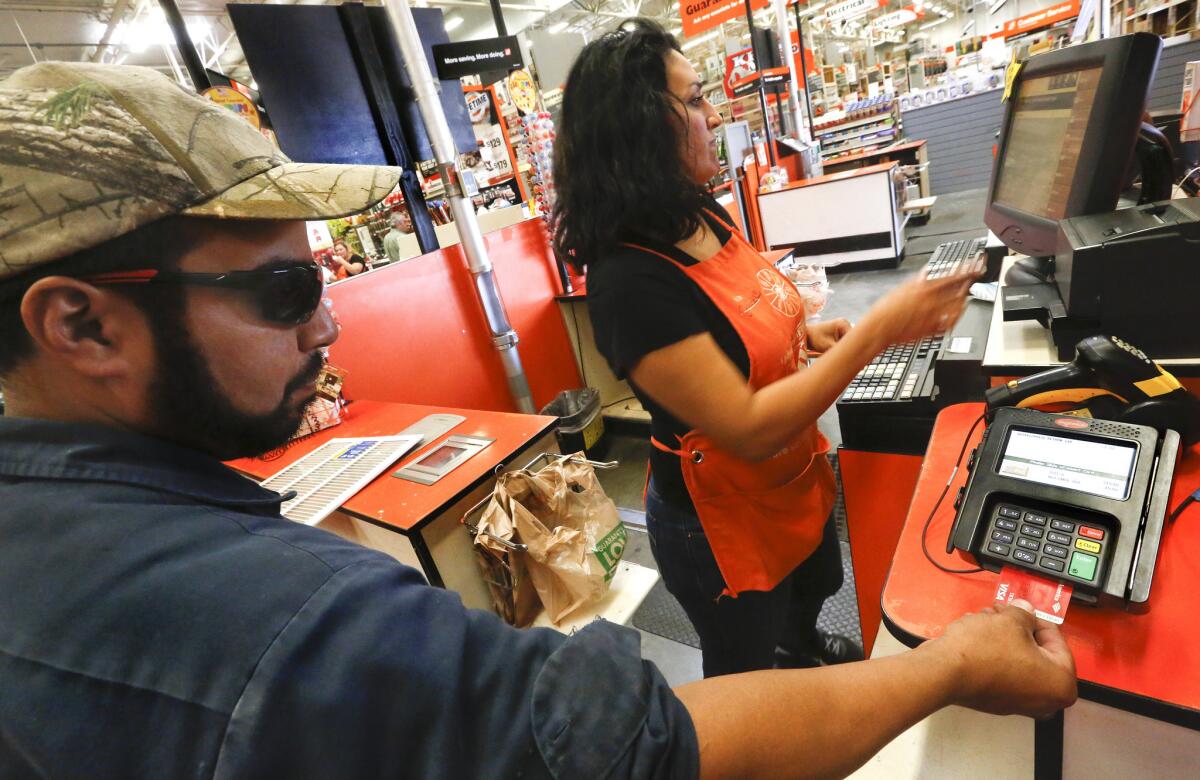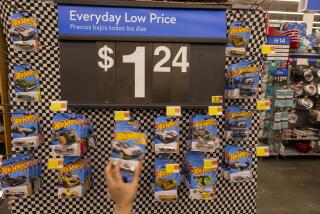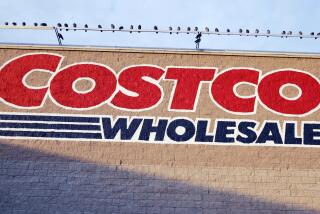This week, credit cards with chips are to become the standard

Cashier Janie Thompson waits as Robert Montanez of San Fernando inserts his card, equipped with an EMV chip, into a new reader at a Home Depot in Burbank.
- Share via
Starting Thursday, most shoppers will no longer be swiping their new credit and debit cards into merchants’ card readers to make purchases. They’ll be inserting them instead — chip side first.
The new pieces of plastic that banks and other card issuers have been sending to customers contain a tiny metallic chip designed to reduce counterfeiting, just as similar Europay credit cards have cut such fraud throughout Europe.
The technology in the microchip makes it more difficult for criminals to forge fakes and easier for merchants to authenticate cardholders.
On Thursday, the credit card industry will add bite to its rollout by shifting liability for covering counterfeits to the party that has not adopted chip technology — either the merchant or the credit card issuer.
SIGN UP for the free California Inc. business newsletter >>
“To the extent that this cuts down on fraud, it’s probably a win for everyone,” said Michael Simkovic, an associate professor at Seton Hall University School of Law.
For merchants, this means ensuring their sales terminals accept the chip technology and contain a slot in their readers for the new cards. Unlike a card swiped quickly, a chip-enabled card must remain in the reader until the machine OKs its removal.
That longer processing time has made some customers uneasy. At a Home Depot in Burbank, Robert Montanez said he worried it would give criminals a greater opportunity to steal his data if the sales terminal were hacked.
“I don’t trust it as much,” said Montanez, 39, of San Fernando. “I leave it in way too long. The swipe is faster.”
About 70% of credit cards will be chip-enabled by the end of the year, said Doug Johnson, senior vice president of payments and cybersecurity policy at the American Bankers Assn., the leading bank trade group.
Prepaid cards also are moving toward chip technology, but at a much slower rate because of a wider variety of offerings, lower value limits and less risk for merchants and card issuers, said Brian Riley, a principal executive advisor at research firm CEB TowerGroup.
Some prepaid cards, such as those for international travel, already carry the chip technology, but many others, including low-value branded gift cards and incentive cards, will probably never convert to EMV, an industry term named after the three companies that created and developed the chip card in the 1990s: Europay, MasterCard and Visa.
The standard magnetic stripe cards will probably remain in circulation for years, said Seth Ruden, senior fraud consultant for the Americas at ACI Worldwide, a payment systems company. Full compliance on the merchant side won’t happen until 2017 when automated fuel dispensers are also required to have payment terminals that read the chip cards.
The change comes as card fraud has more than doubled in the U.S. over the last 15 years while falling in much of the rest of the world where chip-enabled cards have been in place for much of that time.
The cost of fraud in the U.S. rose to 12.8 cents per $100 last year from 5.6 cents in 2000, according to the Nilson Report, which analyzes the global card and mobile payment industries. Last year, the U.S. sustained 48.2% of the world’s card fraud.
The Federal Reserve further broke down some of these numbers in its 2013 triennial study of non-cash payments in the U.S.
The Fed calculated a total of about 13.7 million fraudulent credit card transactions in 2012 totaling $2.3 billion in charges. About 52% of those transactions involved cards that were presented to retailers for purchases; the rest were attributed to online and other fraud where the card isn’t used at a store.
It is that on-site fraud that the chip technology is designed to prevent. About two-thirds of the fraud against Visa involves counterfeit cards, said Stephanie Ericksen, vice president of risk products at Visa Inc.
Though the chip technology won’t end all types of credit card fraud, experts say it’s a needed first step.
“We’re hoping that once we get the magnetic stripe out of the equation that we’ll properly secure the environment,” Ruden said.
Throughout the 2000s, chip cards were rolled out across Europe, and Britain fully implemented EMV technology in 2006. Counterfeit fraud in Britain dropped to 10% of all fraud from 26% over the decade ended 2013, CEB TowerGroup said.
Even though chip-enabled cards are difficult to counterfeit, anti-fraud experts would like to eliminate that possibility altogether. Many already are looking at mobile payment systems as possibly offering better protection.
Using a cellphone also could curtail the online fraud that chip cards can’t touch, said the ABA’s Johnson. Online credit card fraud has skyrocketed to 67% from 29% of all card fraud in Britain over the 10-year span through 2013, a CEB report found.
“What we’re seeing in the U.S. is moving more toward mobile payments,” Riley said.
For now, though, the chip card will become the predominant piece of plastic in consumers’ wallets.
Large retailers such as the Home Depot Inc., Target Inc. and Wal-Mart Stores Inc. said the transition to sales terminals for chip cards is complete or on track to finish by Thursday’s deadline.
But many small businesses said they aren’t ready.
According to a Wells Fargo/Gallup survey in July, 49% of small-business owners said they were aware of the looming shift in liability. But only 31% said their current readers accept chip cards, and only 29% said they intended to make the change before Thursday. One-fifth said they aren’t planning to upgrade at all.
Cost is one factor. Prices for the new readers alone range from $50 to $600.
Madelyn Alfano would have to pay up to $25,000 to update the sales terminals in her 10 Maria’s Italian Kitchen restaurants throughout the Los Angeles area.
She said she will probably get one or two readers for each location in the next few weeks, which could slow down daily operations since the staff usually operates from five sales terminals at each restaurant.
“It’s another expense, another cost of doing business,” she said.
Target’s bill was $100 million to install the payment devices, update the software and issue new credit cards with chips, said spokeswoman Molly Snyder. The National Retail Federation trade group estimated that across the nation, the cost of the new readers, software and other installation costs could hit $35 billion.
Retail associations also pointed out that the U.S. adoption of chip technology is not quite as it was in Europe.
In Europe, customers make purchases by inserting their chip card and punching in a personal identification number, or PIN. U.S. banks can issue cards that require either a signature or a PIN. Retailers and security experts said the chip-and-PIN is more secure because anyone could scrawl a signature with a lost or stolen chip card.
“It’s like locking the front door and leaving the back door wide open,” said J. Craig Shearman, spokesman for the National Retail Federation.
A PIN, however, isn’t foolproof.
“If you’re entering your PIN number in more places, there also are more opportunities for it to be stolen,” said Seton Hall’s Simkovic.
[email protected]
Twitter: @smasunaga
Hoy: Léa esta historia en español
ALSO:
His 83-year-old wife jumped to her death from a Kaiser clinic — why?
Give Gmail address to a retailer? They’ll have an easier time showing you ads on Google
State solar users would lose savings if proposal is OKd; SolarCity describes ‘catastrophic’ future
More to Read
Inside the business of entertainment
The Wide Shot brings you news, analysis and insights on everything from streaming wars to production — and what it all means for the future.
You may occasionally receive promotional content from the Los Angeles Times.











